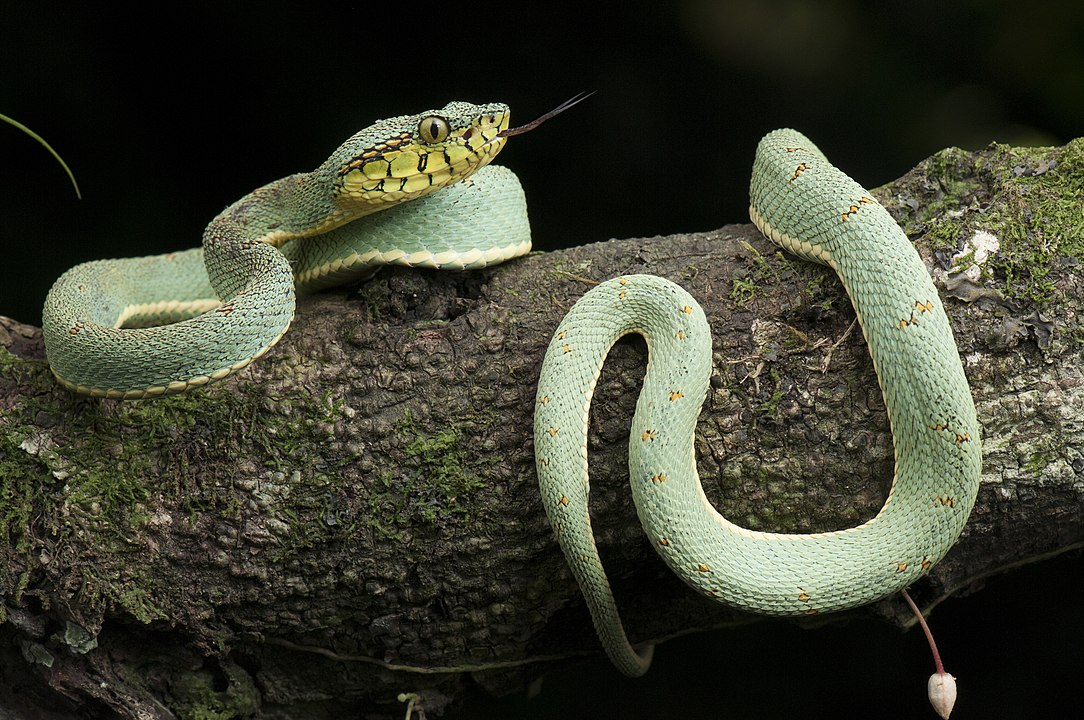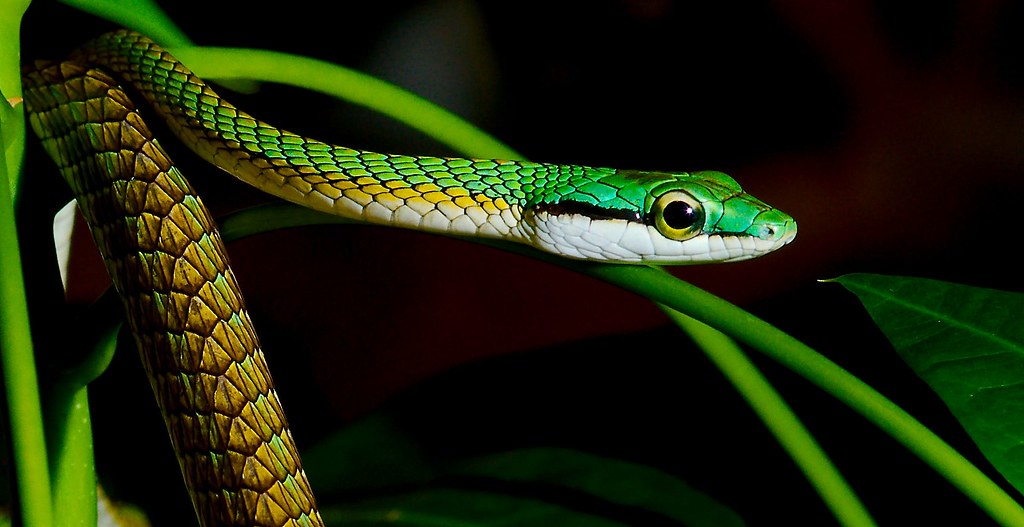In Guyana, there are two species of parrot snakes: Bothrops bilineatus and Leptophis ahaetulla. The Bothrops bilineatus is a venomous pit viper species commonly known as two-striped forest-pit viper and Amazonian palm viper. It is a pale green arboreal species that may reach 1 m (3.3 ft) in length and it is an important cause of snakebite throughout the entire Amazon region. On the other hand, the Leptophis ahaetulla, commonly known as the lora or parrot snake, is a species of medium-sized slender snake of the family Colubridae. This article will give further details about these two species.
Features Of The Bothrops bilineatus Parrot Snake

Parrot Snake (Bothrops bilineatus) By Renato Augusto Martins – Own work, CC BY-SA 4.0, https://commons.wikimedia.org/w/index.php?curid=58767586
- Colour – The colour pattern consists of a pale green ground colour overlaid dorsally with either a peppering of black spots, or a series of tan or reddish-brown spots that are usually paired. The ventrals are bordered by a creamy yellow line running down the length of the body, while the belly itself is yellow and bordered with a tinge of green.
- Tail – The latter part of the tail is pink and bordered with yellow.
- Head – The head is either green with a scattering of small black spots, or green with isolated tan or reddish-brown spots that are bordered in black.
- Iris – The iris is pale green, while the labials are yellow green, often with black spots.
- Body – The body is relatively slender, with a prehensile tail.
- Length – Adults usually do not grow to more than 70 cm (28 in) in length, although some may reach 100 cm (39 in). The maximum reported size is 123 cm (48 in).
- Scalation – The scalation includes 23–35 dorsal scales at midbody, 190–218/192–220 ventral scales in males/females and 65–76/55–73 mostly divided subcaudal scales in males/females. On the head are 5–9 keeled intersupraoculars, 8–12 sublabial scales and 7–9 supralabial scales. Of the latter, the second is usually fused with the prelacunal to form a lacunolabial, although partial or complete sutures may exist to separate these scales.
Did You Know? This species is an important cause of snakebite throughout the entire Amazon region. Due to its arboreal nature, most bites are to the upper body, including hands, arms, and faces. Clinical features of bite wounds include bruising, profound coagulopathy, and spontaneous bleeding. Symptoms reported from various case histories include local pain, swelling, bruising, bleeding of the gums, loss of consciousness, hematemesis, hematuria, fever, erythema, bleeding from the fang punctures, shock, bleeding from the mouth, nose and eyes, nausea, and incoagulable blood. At least one death has been reported.
Features Of The Leptophis ahaetulla Parrot Snake

Parrot Snake (Leptophis ahaetulla) | Starmind Conservation (https://stories.starmind.org/parrot-snake-leptophis-ahaetulla/)
- Length – Adults may attain a total length of 172 cm (68 in), which includes a tail 59 cm (23 in) long.
- Colour – Dorsally, Leptophis ahaetulla is bright green, golden, or bronzy. The keels of the dorsal scales are black or dark brown. The head shields and the dorsal scales may be edged with black. On each side of the head is a black streak which passes through the eye. The upper lip and the belly are white or yellow.
- Head, Eyes & Body – The head is elongated and distinct from the neck. The eye is large with a round pupil. The body is slender, and the tail is long.
- Scales – The dorsal scales are arranged in 15 rows at mid-body and are strongly keeled except in the first row on each side (the row adjacent to the ventrals), where they are smooth. They are also smooth on the neck and tail.
Scientific Classification Of Bothrops bilineatus and Leptophis ahaetulla
Parrot Snake – Bothrops bilineatus
- Kingdom: Animalia
- Phylum: Chordata
- Class: Reptilia
- Order: Squamata
- Suborder: Serpentes
- Family: Viperidae
- Genus: Bothrops
- Species: B. bilineatus
Parrot Snake – Leptophis ahaetulla
- Kingdom: Animalia
- Phylum: Chordata
- Class: Reptilia
- Order: Squamata
- Suborder: Serpentes
- Family: Colubridae
- Genus: Leptophis
- Species: L. ahaetulla
Habitat Of Bothrops bilineatus and Leptophis ahaetulla (Parrot Snakes)
Bothrops bilineatus – This species is found in the Amazon region of South America: Colombia, Venezuela, Guyana, Surinam, French Guiana, Brazil, Ecuador, Peru, and Bolivia. An isolated population is known from the Atlantic versant of southeastern Brazil. The type locality given is “Brasilien”. It is found in lowland rain forest, in shrubbery, palms and trees, especially in the vicinity of water. It is almost always found in bushes and trees along streams or along the edges for forest clearings, mostly associated with primary forest, although has also been found in older secondary forest near primary forest.
Leptophis ahaetulla – Can be found in Central America: Belize, Costa Rica, El Salvador, Guatemala, Honduras, southern Mexico, Nicaragua, Panama. Also in South America: Argentina, Bolivia, Brazil, Colombia, Ecuador, French Guiana, Guyana, Paraguay, Peru, Trinidad and Tobago, Uruguay, Venezuela.
Diet Of Bothrops bilineatus and Leptophis ahaetulla (Parrot Snakes)
Bothrops bilineatus – The diet consists of small mammals, such as mouse opossums (Marmosa), mice, birds, lizards, and frogs. Juveniles tend to remain closer to the ground to feed on small frogs and lizards.
Leptophis ahaetulla – It feeds on lizards, frogs, and small birds.
Bothrops bilineatus and Leptophis ahaetulla (Parrot Snakes) In Guyana
The two species of parrot snakes found in Guyana are indeed unique. They have their own abilities and features. For example, the Bothrops bilineatus is nocturnal; this species spends the day hidden in thick foliage, tree hollows, or at the base of palm fronds, and always in places where it can anchor itself with its prehensile tail. It tends to rely on ambush instead of actively hunting for prey. As for the Leptophis ahaetulla, it was thought to be non-venomous, but it is mildly venomous with localized pain, swelling and a feeling “pins and needles” being the symptoms of envenomation. Symptoms disappear after a few hours. Guyana is privileged to have these two species of parrot snakes.
Article References:
- http://guyanachronicle.com/2017/06/25/snake-snake
- https://en.wikipedia.org/wiki/Bothrops_bilineatus
- https://en.wikipedia.org/wiki/Leptophis_ahaetulla
- https://www.stabroeknews.com/2012/08/19/features/vipers/
- Main Image: Bothrops bilineatus By Renato Augusto Martins – Own work, CC BY-SA 4.0, https://commons.wikimedia.org/w/index.php?curid=58767586






